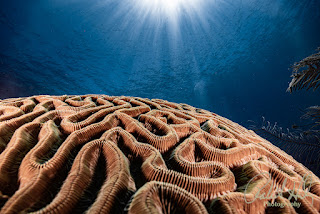The Art of White Balance in Underwater Photography: Unveiling the True Colors with Adobe Lightroom
Introduction:
In this week's blog, I want to discuss "White
Ballance", what it is, what it does to underwater photographs, and how to
compensate for it using Adobe Lightroom.
Diving into the captivating realm beneath the waves as an
underwater photographer opens a world of wonder and beauty. To capture the
essence and vibrancy of this underwater world, understanding and mastering
white balance is of paramount importance. In this comprehensive guide, I will
explore the concept of white balance and its significance in underwater
photography. I will also delve into the intricacies of using white balance
within Adobe Lightroom to elevate your underwater images to new heights.
Understanding
White Balance:
White balance is the process of adjusting the colors in an
image to ensure that whites appear neutral, regardless of the lighting
conditions under which the photo was taken. Different light sources emit
varying color temperatures, and white balance allows us to restore the true
colors of our subjects by compensating for the color cast created by the
lighting environment.
Significance
of White Balance in Underwater Photography:
The underwater world presents unique challenges when it
comes to capturing accurate colors. Water acts as a filter, absorbing and
scattering light as it travels through. Different colors of light are absorbed
in varying depths, resulting in color loss and an overall blue or green cast in
underwater images. By effectively adjusting the white balance, we can
counteract these color shifts and bring back the true colors of the underwater
environment, revealing the awe-inspiring beauty hidden beneath the surface.
The color
shift in saltwater as a function of depth:
In saltwater environments, the
following general color shifts occur as you descend to greater depths:
- Surface Level (0-5 meters): At the surface, where ample sunlight penetrates the water, colors are relatively accurate, although the presence of water itself can introduce a slight blue or green cast. Reds, oranges, and yellows remain vibrant and true to their natural hues.
- Shallow Depths (5-15 meters): As you descend into shallow depths, longer-wavelength colors such as red and orange start to diminish due to the absorption of light by water. The water acts as a filter, absorbing the longer wavelengths more strongly, resulting in a gradual loss of warm colors. The remaining colors may appear slightly cooler or cyan-tinted.
- Mid Depths (15-30 meters): In this range, the color shift becomes more pronounced. Reds and oranges are greatly absorbed, and yellows also start to fade. The predominant color cast is usually a cyan or bluish-green tint, as shorter-wavelength colors, like blue and green, are more effectively transmitted through the water.
- Deep Depths (30+ meters): At greater depths, the underwater environment is predominantly blue or green. Most of the warm tones, including reds, oranges, and yellows, are absorbed by the water, resulting in an overall cool and monochromatic appearance. The depth and clarity of the water, as well as other factors like suspended particles or algae, can influence the specific color shifts experienced.
It's important to note that these color shifts are generalizations and can vary depending on factors such as water clarity, time of day, weather conditions, and geographical location. Additionally, different light sources, such as artificial lights or strobes, can also influence color rendition underwater.
Understanding the color shifts that occur at different
depths in saltwater is crucial for underwater photographers. By being aware of
these changes, you can make informed decisions about lighting, white balance
adjustments, and the use of artificial lighting to effectively restore and
enhance the true colors of your underwater subjects during post-processing.
Harnessing
White Balance in Adobe Lightroom:
Adobe Lightroom is a powerful post-processing tool that
offers a myriad of options to fine-tune white balance and bring out the best in
your underwater images. Let's explore the step-by-step process of utilizing
white balance within Lightroom:
1. Importing
Images: Launch Adobe Lightroom and import your underwater images into the
library module, organizing them for easy access and management.
2. Selecting
an Image: Choose the image you wish to work on and switch to the develop
module, where the magic of post-processing unfolds.
3. White
Balance Adjustment Tools: On the right side of the develop module, locate
the Basic panel, which houses various white balance adjustment tools to help
you achieve accurate and visually appealing colors.
4. Auto
White Balance: Start by experimenting with the "Auto" option.
Lightroom analyzes the image and attempts to correct the white balance
automatically. While this can be a convenient starting point, it may not always
deliver the desired results due to the complexities of underwater lighting
conditions.
5. White
Balance Presets: Lightroom provides presets specifically designed for
different lighting scenarios. These presets are a great starting point for
adjusting white balance and can be applied with a single click. Explore the preset
options and choose the one that best complements your image.
6. Temperature
and Tint Sliders: For precise control over white balance, utilize the
temperature and tint sliders located in the Basic panel. The temperature slider
adjusts the overall warmth or coolness of the image, while the tint slider
enables you to remove or add magenta or green tones. Gradually adjust these
sliders to achieve the desired color balance in your underwater image.
7. White
Balance Selector Tool: Lightroom's white balance selector tool, represented
by an eyedropper icon, allows you to click on a neutral area in your
image—ideally a gray or white subject—and automatically adjust the white
balance based on that selection. This feature can be particularly useful when
there is an absence of true white or gray subjects in the image.
8. Fine-Tuning
the White Balance: After applying initial adjustments, closely observe the
impact on the colors and fine-tune the white balance using the temperature and
tint sliders. Experiment with different settings until you achieve a natural,
visually appealing color balance that accurately represents the underwater
scene.
9. Sync
or Copy Settings: If you have a series of images captured under similar
lighting conditions, you can save time by synchronizing or copying the white
balance settings from one image to the others. This ensures consistency and
efficiency in your post-processing workflow.
Conclusion:
Mastering white balance is an essential skill for underwater photographers to accurately portray the mesmerizing colors of the underwater realm. Adobe Lightroom provides a robust suite of tools to effectively adjust white balance and enhance the visual impact of your underwater images. By understanding the principles of white balance and practicing with Lightroom's features, you can breathe life into your underwater photographs, unveiling the true colors and captivating viewers with the beauty beneath the waves. So, dive in, explore, and let your underwater images shine through the art of white balance. Happy capturing and processing!
The above might seem intimidating and complex. Allow
me to show you how to simplify this important process in my upcoming online
training course which I will be announcing soon. If you have an interest in
learning more, send me your email and let me know (bob@robertherb.com).
Visit my website (Robert Herb Photography) to see examples of my work.
I also look forward to all comments and suggestions.
Bob Herb



Comments
Post a Comment
Please let me know your comments.